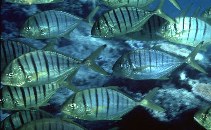Gnathanodon speciosus (Forsskål, 1775)
Golden trevally
添加你自己的观测位置在 Fish Watcher
| Native range | All suitable habitat | Point map | Year 2050 |

|
| This map was computer-generated and has not yet been reviewed. |
| Gnathanodon speciosus AquaMaps Data sources: GBIF OBIS |
Saudi Arabia country information
Common names:
[No common name]
Occurrence: native
Salinity: marine
Abundance: | Ref:
Importance: | Ref:
Aquaculture: | Ref:
Regulations: | Ref:
Uses: no uses
Comments: Based on Photo by J.E. Randall. Jana Island. Remark: 1.17 kg. Also collected off Jizan, southern Saudi Arabian Red Sea coast (Ref. 99978).
National Checklist:
Country Information: https://www.cia.gov/library/publications/resources/the-world-factbook/geos/sa.html
National Fisheries Authority:
Occurrences: Occurrences Point map
Main Ref: Randall, J.E., 1997
National Database:
Occurrence: native
Salinity: marine
Abundance: | Ref:
Importance: | Ref:
Aquaculture: | Ref:
Regulations: | Ref:
Uses: no uses
Comments: Based on Photo by J.E. Randall. Jana Island. Remark: 1.17 kg. Also collected off Jizan, southern Saudi Arabian Red Sea coast (Ref. 99978).
National Checklist:
Country Information: https://www.cia.gov/library/publications/resources/the-world-factbook/geos/sa.html
National Fisheries Authority:
Occurrences: Occurrences Point map
Main Ref: Randall, J.E., 1997
National Database:
Common names from other countries
分类 / Names 俗名 | 同种异名 | Catalog of Fishes(属, 种) | ITIS | CoL | WoRMS | Cloffa
Teleostei > Carangiformes (Jacks) 鱸形目 (Jacks) > Carangidae (Jacks and pompanos) > Caranginae
Etymology: Gnathanodon: Greek, gnathos = jaw + Greek, odous = teeth (Ref. 45335).
More on author: Forsskål.
Etymology: Gnathanodon: Greek, gnathos = jaw + Greek, odous = teeth (Ref. 45335).
More on author: Forsskål.
Environment: milieu / climate zone / depth range / distribution range 生态学
海洋 礁区鱼类; 深度上下限 0 - 80 m (Ref. 86942). 熱帶; 35°N - 31°S, 30°E - 77°W
分布 国家 | FAO区域 | 生态系 | 标本纪录 | Point map | 简介 | Faunafri
Indo-Pacific: from Kwazulu-Natal, South Africa, north to Mie Prefecture, Japan and east to southwestern coast of Baja California Sur, Mexico and Gulf of California to Ecuador (Ref. 9283).
印度-太平洋。 東太平洋: 墨西哥南下加利福尼亞與加州灣到厄瓜多的西南方海岸.(參考文獻 9283)
印度-太平洋。 東太平洋: 墨西哥南下加利福尼亞與加州灣到厄瓜多的西南方海岸.(參考文獻 9283)
Length at first maturity / 大小 / 重量 / 年龄
Maturity: Lm 32.5 range ? - ? cm
Max length : 120 cm TL 雄鱼/尚未辨别雌雄; (Ref. 11441); common length : 75.0 cm FL 雄鱼/尚未辨别雌雄; (Ref. 9283); 最大体重: 15.0 kg (Ref. 30874)
Max length : 120 cm TL 雄鱼/尚未辨别雌雄; (Ref. 11441); common length : 75.0 cm FL 雄鱼/尚未辨别雌雄; (Ref. 9283); 最大体重: 15.0 kg (Ref. 30874)
简单描述 检索表 | 型态特徵 | 形态测量图
背棘 (总数) : 8; 背的软条 (总数) : 18 - 20; 臀棘: 3; 臀鳍软条: 15 - 17.
稚鱼与年青的成鱼颜色鲜黄色的到银色的; 宽而狭窄的黑色横带交互的; 鳍黄色。 在侧边上成鱼有少数黑色的斑块或斑点; 横带, 如果呈现, 非常模糊的。 唇厚而肉质的。 胸部鳞片覆盖完整。 胸鳍镰刀状的 ; 臀鳍有 2根分离的棘
稚鱼与年青的成鱼颜色鲜黄色的到银色的; 宽而狭窄的黑色横带交互的; 鳍黄色。 在侧边上成鱼有少数黑色的斑块或斑点; 横带, 如果呈现, 非常模糊的。 唇厚而肉质的。 胸部鳞片覆盖完整。 胸鳍镰刀状的 ; 臀鳍有 2根分离的棘
Adults occur in deep lagoon and seaward reefs where they feed by rooting for crustaceans and fossorial invertebrates in the sand but they also feed on small fishes (Ref. 9710, 90102). Small juveniles live among the tentacles of jellyfish (Ref. 9710). Adults form schools and are also noted for their behavior to closely swim around sharks and other large fishes, and also follow divers (Ref. 10361). Juveniles particularly display this piloting behavior to gain protection from likely predators (Ref. 9710, 90102). Marketed fresh and salted or dried (Ref. 9283). Juveniles are used in the aquarium trade. Minimum depth reported taken from Ref. 128797.
出现于深的泻湖与临海礁石在哪里它们藉着为甲壳动物与其他的无脊椎动物根在砂中觅食。 也吃小鱼。 小的稚鱼生活在水母的触须之中。 (参考文献 9710) 形成鱼群。 它是被记录到让它的行为紧靠在鲨鱼周围游泳与其他的大鱼, 也跟随潜水者 (参考文献 10361) 得到保护避开可能的掠食者.(参考文献 9710) 在市场上销售生鲜地了与盐腌或乾燥的.(参考文献 9283) 稚鱼被用于水族贸易。
出现于深的泻湖与临海礁石在哪里它们藉着为甲壳动物与其他的无脊椎动物根在砂中觅食。 也吃小鱼。 小的稚鱼生活在水母的触须之中。 (参考文献 9710) 形成鱼群。 它是被记录到让它的行为紧靠在鲨鱼周围游泳与其他的大鱼, 也跟随潜水者 (参考文献 10361) 得到保护避开可能的掠食者.(参考文献 9710) 在市场上销售生鲜地了与盐腌或乾燥的.(参考文献 9283) 稚鱼被用于水族贸易。
Life cycle and mating behavior 成熟度 | 繁殖 | 产卵场 | 卵 | 孕卵数 | 仔鱼
印度-太平洋。 東太平洋: 墨西哥南下加利福尼亞與加州灣到厄瓜多的西南方海岸.(參考文獻 9283)
主要参考文献
Upload your references | 参考文献 | 合作者 : Smith-Vaniz, William F. | 合作者
Smith-Vaniz, W.F., 1995. Carangidae. Jureles, pámpanos, cojinúas, zapateros, cocineros, casabes, macarelas, chicharros, jorobados, medregales, pez pilota. p. 940-986. In W. Fischer, F. Krupp, W. Schneider, C. Sommer, K.E. Carpenter and V. Niem (eds.) Guia FAO para Identification de Especies para lo Fines de la Pesca. Pacifico Centro-Oriental. 3 Vols. FAO, Rome. (Ref. 9283)
人类利用
渔业: 低经济; 养殖: 商业性; 游钓鱼种: 是的; 水族馆: 商业性
FAO(渔业: 产生; publication : search) | FishSource | 周边海洋
更多信息
Population dynamics
成长参数
Max. ages / sizes
Length-weight rel.
Length-length rel.
体长-频率
Mass conversion
入添量
丰度
成长参数
Max. ages / sizes
Length-weight rel.
Length-length rel.
体长-频率
Mass conversion
入添量
丰度
Physiology
Body composition
Nutrients
耗氧量
游泳类型
游泳速度
Visual pigments
Fish sound
Diseases & Parasites
Toxicity (LC50s)
Body composition
Nutrients
耗氧量
游泳类型
游泳速度
Visual pigments
Fish sound
Diseases & Parasites
Toxicity (LC50s)
Genetics
遗传学
Heterozygosity
遗传率
遗传学
Heterozygosity
遗传率
工具
Bio-Quiz | E-book | 野外调查 | 检索表 | 长度- 频率 Wizard | 生活- 历史的工具 | 分布图 | Classification Tree
| Catch-MSY |
特别资料
下载 XML
网络资源
Aquatic Commons | BHL | Cloffa | BOLDSystems | Websites from users | 核实 FishWatcher | CISTI | Catalog of Fishes(属, 种) | DiscoverLife | DORIS | ECOTOX | Faunafri | Fishtrace | GenBank(基因组, 核苷酸) | GloBI | GOBASE | | Google Books | Google Scholar | Google | IGFA World Record | MitoFish | 国家资料库 | Otolith Atlas of Taiwan Fishes | 公众的水族馆 | PubMed | Reef Life Survey | Scirus | SeaLifeBase | 树状分类阶层 | Wikipedia(转至, 搜寻) | World Records Freshwater Fishing | 动物学的记录
Estimates based on models
Phylogenetic diversity index (Ref. 82804): PD50 = 1.0000 [Uniqueness, from 0.5 = low to 2.0 = high].
Bayesian length-weight: a=0.01318 (0.01176 - 0.01478), b=2.96 (2.93 - 2.99), in cm Total Length, based on LWR estimates for this species (Ref. 93245).
营养阶层 (Ref. 69278): 4.0 ±0.52 se; based on food items.
回复力 (Ref. 120179): 中等的, 族群倍增时间最少 1.4 - 4.4年 (K=0.14-0.53).
Prior r = 0.57, 95% CL = 0.37 - 0.85, Based on 1 data-limited stock assessment.
Fishing Vulnerability (Ref. 59153): Moderate vulnerability (43 of 100).
Climate Vulnerability (Ref. 125649): Very high vulnerability (86 of 100).





